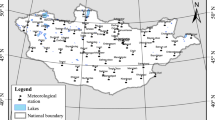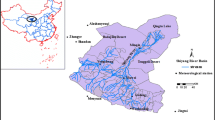Abstract
Analyses of the variation characteristics for aridity index (AI) can further enhance the understanding of climate change and have effect on hydrology and agriculture. In this paper, based on the data of 283 standard meteorological stations, the temporal-spatial variations and the influences of climate factors on AI were investigated and the relationship between AI and two climate indices (the Arctic Oscillation (AO); El Nino-Southern Oscillation (ENSO)) were also assessed in northern China (NC) during the period from 1961 to 2012. The results revealed that the annual mean AI decreased at the rate of −0.031 per decade in the past 52 years and the trend was statistically significant at the 0.01 level. The Mann-Kendall (M-K) test presented that the percentages of stations with positive trends and negative trends for AI were 10 and 81.9 % (22.6 % statistically significant), respectively. Spatially, in the western part of 100° E, the extremely dry area declined and the climate tended to become wet obviously. In the eastern part of 100° E, dry area moved toward the east and the south, which resulted in the enhancement of semiarid area and the shrinkage of subhumid area. The contributions of sunshine duration and precipitation to the decline of AI are more than those of other meteorological variables in NC. Moreover, the average temperature has risen significantly and AI decreased in NC, which indicated the existence of “paradox.” Relationship between climate indices (AO and ENSO) and AI demonstrated that the influence of ENSO on AI overweight the AO on AI in NC.






Similar content being viewed by others
References
Ahani H, Kherad M, Kousari MR, van Roosmalen L, Aryanfar R, Hosseini SM (2013) Non-parametric trend analysis of the aridity index for three large arid and semi-arid basins in Iran. Theor Appl Climatol 112:553–564. doi:10.1007/s00704-012-0747-2
Allen RG, Pereira LS, Raes D, Smith M (1998) Crop evapotranspiration-guidelines for computing crop water requirements. FAO irrigation and drainage paper. Rome, Italy, p.56
Bannayan M, Sanjani S, Alizadeh A, Lotfabadi SS, Mohamadian A (2010) Association between climate indices, aridity index, and rainfed crop yield in northeast of Iran. Field Crop Res 118:105–114. doi:10.1016/j.fcr.2010.04.011
Chaouche K, Neppel L, Dieulin C, Pujol N, Ladouche B, Martin E, Salas D, Caballero Y (2010) Analyses of precipitation, temperature and evapotranspiration in a French Mediterranean region in the context of climate change. Compt Rendus Geosci 342:234–243
Chattopadhyay N, Hulme M, Leclerc MY (1997) Evaporation and potential evapotranspiration in India under conditions of recent and future climate change. Agric For Meteorol 87:55–73
Frich P, Alexander LV, Della-Marta P, Gleason B, Haylock M, Tank AK, Peterson T (2002) Observed coherent changes in climatic extremes during the second half of the twentieth century. Clim Res 19:193–212
Gao X, Giorgi F (2008) Increased aridity in the Mediterranean region under greenhouse gas forcing estimated from high resolution simulations with a regional climate model. Glob Planet Chang 62:195–209
Goossens C, Berger A (1986) Annual and seasonal climatic variations over the Northern Hemisphere and Europe during the last century. Ann Geophys 4:385–399
Grinsted A, Moore J C, Jevrejeva S (2004) Application of the cross wavelet transform and wavelet coherence to geophysical time series. Nonlinear Process Geophys 11:561–566
Huo ZL, Dai XQ, Feng SY, Kang SZ, Huang GH (2013) Effect of climate change on reference evapotranspiration and aridity index in arid region of China. J Hydrol 492:24–34
IPCC (2007) In: Solomon S, Qin D, Manning M, Chen Z, Marquis M, Averyt K, Tignor M, Miller HL (eds) Climate change 2007. The physical science basis. Contribution of Working Group I to the Fourth Assessment Report of the Intergovernmental Panel on Climate Change. Cambridge University Press, Cambridge, p. 996
Keyantash J, Dracup JA (2002) The quantification of drought: an evaluation of drought indices. Bull Am Meteorol Soc 83:1167–1180
Liu Q, Yang ZF (2010) Quantitative estimation of the impact of climate change on actual evapotranspiration in the Yellow River Basin, China. J Hydrol 395:226–234. doi:10.1016/j.jhydrol.2010.10.031
Liu Q, Yang Z F, Cui B S (2008). Spatial and temporal variability of annual precipitation during 1961e2006 in Yellow River Basin, China. J Hydrol 361:330–338
Liu XM, Zhang D, Luo YZ, Liu CM (2013) Spatial and temporal changes in aridity index in northwest China: 1960 to 2010. Theor Appl Climatol 112:307–316. doi:10.1007/s00704-012-0734-7
Ma ZG, Fu CB (2003) Interannual characteristics of the surface hydrological variables over the arid and semi-arid areas of northern China. Glob Planet Chang 37:189–200. doi:10.1016/S0921-8181(02)00203-5
Ma ZG, Fu CB (2006) Some evidence of drying trend over northern China from 1951 to 2004. Chin Sci Bull 51:2913–2925. doi:10.1007/s11434-006-2159-0
Michael LR, Graham DF (2004) Changes in Australian pan evaporation from 1970 to 2002. Int J Climatol 24:1077–1090
Paltineanu C, Mihailescu IF, Seceleanu I (2007) Using aridity indices to describe some climate and soil features in Eastern Europe: a Romanian case study. Theor Appl Climatol 90:263–274. doi:10.1007/s00704-007-0295-3
Peterson TC, Golubev VS, Groisman PY (1995) Evaporation losing its strength. Nature 377:687–688
Roderick ML, Farquhar GD (2002) The cause of decreased pan evaporation over the past 50 years. Science 298:1410–1411. doi:10.1126/science.1075390-a
Roderick ML, Farquhar GD (2005) Changes in New Zealand pan evaporation since the 1970s. Int J Climatol 25:2031–2039
Roderick ML, Rotstayn LD, Farquhar GD (2007) On the attribution of changing pan evaporation. Geophys Res Lett 34:L17403. doi:10.1029/2007GL031166
Sahin S (2012) An aridity index defined by precipitation and specific humidity. J Hydrol 444-445:199–208. doi:10.1016/j.jhydrol.2012.04.019
Seager R, Ting MF, Held I (2007) Model projections of an imminent transition to a more arid climate in south-western North America. Science 316:1181–1184. doi:10.1126/science.1139601
Sheffield J, Wood EF, Roderick ML (2012) Little change in global drought over the past 60 years. Nature 491:435–438
Shi YF, Shen YP, Kang E (2007) Recent and future climate change in northwest China. Clim Chang 80:379–393. doi:10.1007/s10584-006-9121-7
Tabari H, Aghajanloo MB (2013) Temporal pattern of aridity index in Iran with considering precipitation and evapotranspiration trends. Int J Climatol 33:396–409. doi:10.1002/joc.3432
Thornthwaite CW (1948) An approach toward a rational classification of climate. Geogr Rev 38:55–94
Torrence C, and Webster P (1999) Interdecadal changes in the ENSO–monsoon system. J Clim 12:2679–2690
UNESCO (1979) Map of the world distribution of arid regions. Map at scale 1:25,000,000 with Explanatory Note. UNESCO, Paris, 54p, ISBN, 92–3–101484-6.
Wang L (2004) Changes of humid index and borderline of wet and dry climate zone in northern China over the past 40 years. Geogr Res 23:45–54
Wang G (2005) Agricultural drought in a future climate: results from15 global climate models participating in the IPCC 4th assessment. Clim Dynam 25:739–753
Wang ZW, Zhai PM (2003) Climate change in drought over northern China during 1950-2000. Sci Geogr Sin 58:61–68
Wang ZY, Ding YH, He JM (2004) An updating analysis of the climate change in China in recent 50 years. Acta Meteorologica Sinica 62:228–236
Yang XG, LIiu ZJ, Chen F (2011) The possible effects of global warming on cropping systems in China VI. Possible effects of future climate change on northern limits of cropping system in China. Sci Agric Sin 44(8):1562–1570
Yang YH, Zhao N, Hu YK (2009) Effect of wind speed on sunshine hours in three cities in northern China. Clim Res 39:149–157
Yin YH, Wu SH, Dai EF (2010) Determining factors in potential evapotranspiration changes over China in the period 1971-2008. Chin Sci Bull 55:3329–3337. doi:10.1007/s11434-010-3289-y
Yu MX, Li Q, Hayes MJ, Svoboda MD, Heim RR (2014) Are droughts becoming more frequent or severe in China based on the Standardized Precipitation Evapotranspiration Index: 1951–2010? Int J Climatol 34:545–558. doi:10.1002/joc.370
Zhai PM, Pan XH (2003) Change in extreme temperature and precipitation over northern China during the second half of the 20th century. Acta Geograph Sin 58:1–10
Zhang D, Liu XM, Luo YZ (2013) Spatial and temporal changes in aridity index in Northwest China: 1960 to 2010. Theor Appl Climatol 112:307–316. doi:10.1007/s00704-012-0734-7
Zhang KX, Pan SM, Zhang W, XuYH CLG, Hao YP (2015) Influence of climate change on reference evapotranspiration and aridity index and their temporal-spatial variations in the Yellow River Basin, China, from 1961 to 2012. Quatern Int 380:75–82. doi:10.1016/j.quaint.2014.12.037
Zhang SH, Liu SX, Mo XG, Shu C, Sun Y, Zhang C (2011) Assessing the impact of climate change on potential evapotranspiration in Aksu River Basin. J Geogr Sci 21:609–620. doi:10.1007/s 11442-011-0867-0
Zhang X, Ren Y, Yin ZY (2009a) Spatial and temporal variation patterns of reference evapotranspiration across the Qinghai-Tibetan Plateau during 1970–2004. J Geophys Res 114:D15105, doi:10.1029/2009JD011753.
Zhang Q, Xu CY, Zhang ZX (2009b) Observed changes of drought/wetness episodes in the Pearl River basin, China, using the standardized precipitation index and aridity index. Theor Appl Climatol 99:89–99. doi:10.1007/s00704-008-0095-4
Zhao YF, Zou XQ, Cao LG, Xu XWH (2014) Changes in precipitation extremes over the Pearl River Basin, southern China, during 1960–2012. Quatern Int 333:26–39. doi:10.1016/j.quaint.2014.03.060
Acknowledgments
We greatly appreciate the suggestions for improving the manuscript given by the reviewers and Professor Hartmut Graßl (editor-in-chief). This study was supported by the National Natural Science Foundation of China (Grant Nos. 41271289 and 41501286). Thanks also to the editorial staff.
Author information
Authors and Affiliations
Corresponding authors
Rights and permissions
About this article
Cite this article
Zhang, K., Qian, X., Liu, P. et al. Variation characteristics and influences of climate factors on aridity index and its association with AO and ENSO in northern China from 1961 to 2012. Theor Appl Climatol 130, 523–533 (2017). https://doi.org/10.1007/s00704-016-1887-6
Received:
Accepted:
Published:
Issue Date:
DOI: https://doi.org/10.1007/s00704-016-1887-6




